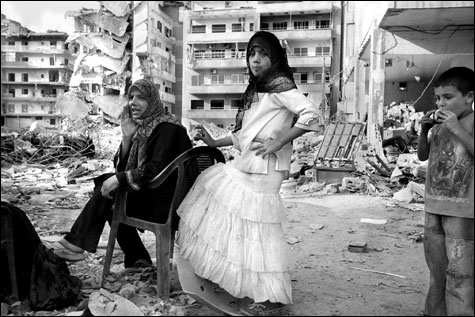
DEFIANT: Rania Matar's photos show women and children living amid the rubble of war in her
native Lebanon. |
| “The 2008 Foster Prize” | “Momentum 12: Gerard Byrne” | “Ugo Rondinone: Clockwork for Oracles” | Institute Of Contemporary Art, 100 Northern Ave, Boston | “Foster” + “Byrne” |Through March 1 | “Rondinone” Through November 1 |
On November 12, the Institute of Contemporary Art opened its biennial Foster Prize exhibit of "Boston-area artists of exceptional promise." The game show works like this: four finalists present their work in the museum and we wait till early 2009 for the institution to announce the $25,000 winner. (The three others get $1500 consolation prizes.) So for those of you playing along at home, let's meet the contestants.
Catherine (Kanarinka) D'Ignazio of Waltham, best known locally as a founding member of the Institute for Infinitely Small Things and other local art gangs, goes solo here with recent work addressing the climate of fear drummed up by our leaders since 9/11. Last year she jogged most of Boston's disaster evacuation routes (you've probably seen the signs) while recording her breathing. Those recordings are broadcast here along with a new video installation, Exit Strategy. In a loop of quick cuts, D'Ignazio exits through doors (slam, slam, slam) all over the ICA building but never escapes. The slamming and the insidious breathing induce extreme, punishing claustrophobia. It's very effective, and terribly unpleasant.

Rania Matar of Brookline presents black-and-white photos of women and children living amid the rubble of war in her native Lebanon. A hole that a rocket blasted through a bullet-pocked wall frames an ornate building behind. A stout Orthodox Christian nun's veil ripples in the wind. A girl hugs the concrete-block corner of a bare room in a Palestinian refugee camp. A family hang out in the debris where their apartment used to be. Running through the images is a meditation on Muslim and Christian women adopting the veil.
This is the fifth exhibit I've seen of this work. In the past I've felt that Matar would make a good newspaper photojournalist but that her work needed more urgency or vision. This grouping is more vivid, more dramatically composed — even though it includes familiar shots. I think that's because the images have been more sharply selected.
Joe Zane of Cambridge makes dry, cerebral, art-referential, self-depreciating joke paintings and sculptures about the nature of art and museums and what it means to be a great artist. He's explored these themes in past work; he addresses them in the context of the Foster competition with pieces like a silver-plated trophy whose shape is based on his profile.
Zane questions artistic originality, the nature of representation, and the artist's ego with a pair of seemingly identical paintings of himself — which he commissioned from a factory in China. The Triumph of Parrhasius, a third painting from that factory, seems to be another copy of the portrait partly hidden behind a trompe-l'oeil veil. The title refers to the ancient Greek painter Parrhasius, who is said to have competed with Zeuxis to determine who was the greater artist. Zeuxis painted grapes so lifelike that birds flew down to eat them. Then Zeuxis asked Parrhasius to unveil his painting, only to learn that the curtain was part of the painting. Snap!
Bostonian Andrew Witkin's installation appears to be a combo of a high-end boutique furniture showroom and art monk's cell. It features exquisitely spare plywood furniture: a day bed, an end table, a large table (looks like an interior-design geek's ping-pong table), and deep shelves neatly stacked with boxes and portfolios. Atop the shelves sit precisely arranged photos and clippings showing fashion models, boxers, a couple, a chair. It's easy to miss the visual rhyme Witkin makes between a stain across a leaky ceiling in a photo and pink printing stains on a couple of newspaper clippings.
This is a polished but difficult installation, and frustratingly buttoned up, right down to a row of framed somethings stacked next to another so that you can't see what any one of them is. "It's a place of potential," Witkin tells me. "No rules, no decisions, no final decisions, but nonetheless careful."
A typed sheet of paper on the end table describes meeting a friend and his twin brother with HIV — and offers clues as to what Witkin is up to. Key passage: "I wished I could photograph him. As he was talking, I felt shame for thinking of art when this man was talking about such pain, suffering, and death. . . . It was not the time or place to be thinking about art but the topic, his appearance, his clothing, and the light all kept me thinking about art." Witkin looks to turn life into art by æstheticizing it, putting it in the perfect OCD order.
Who will win the Foster Prize? I suspect visitors will be most attracted to Matar's photos. But my guess is that the jury will pick Witkin. His work, which has an air of correcting the world via awesomely tasteful home decoration, rubs me wrong. But you can't deny the force of his vision.